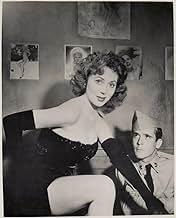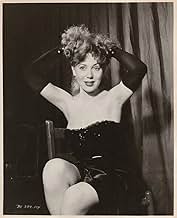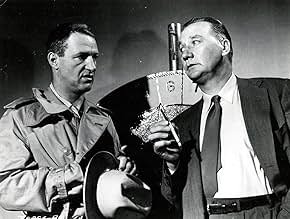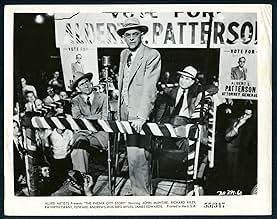CALIFICACIÓN DE IMDb
7.2/10
3.5 k
TU CALIFICACIÓN
Un abogado que lucha contra el crimen y su padre se enfrentan a las fuerzas y la prostitución en su pequeña ciudad del sur.Un abogado que lucha contra el crimen y su padre se enfrentan a las fuerzas y la prostitución en su pequeña ciudad del sur.Un abogado que lucha contra el crimen y su padre se enfrentan a las fuerzas y la prostitución en su pequeña ciudad del sur.
- Dirección
- Guionistas
- Elenco
- Premios
- 1 premio ganado y 1 nominación en total
Kathy Marlowe
- Mamie
- (as Katharine Marlowe)
- Dirección
- Guionistas
- Todo el elenco y el equipo
- Producción, taquilla y más en IMDbPro
Opiniones destacadas
I'm surprised that more people are not aware of this story which climaxed with no less than the murder of the Democratic nominee for Attorney General of Alabama at the time when said nomination was tantamount to election. That the election of Albert Patterson scared the local criminal syndicate into that kind of move is almost unprecedented. The only other example I can think of something like this occurring was in the early years of the last century when Special Prosecutor Francis J. Heney was shot and wounded while he was investigated the corrupt city machine in San Francisco.
After a brief documentary introduction by CBS news reporter Clete Roberts of actual Phenix City residents, the story begins with the Pattersons, father John McIntire and son Richard Kiley getting reluctantly involved in the fight to clean up their town which is notorious for being a wide open cesspool of vice and corruption. It's pointed out that Phenix City is across from Columbus, Georgia and thirty minutes from Fort Benning. A certain amount of vice and corruption will inevitably settle there in towns that cater to the military and the pleasures the service people will seek off duty.
But Phenix City has gotten way out of hand and it's become a state embarrassment to the people of Alabama. Which is why John McIntire wins that primary leading the way to the unheard of events that followed. Let's just say that what happens here was contemplated, but never done in Chicago during the days of Al Capone.
The cast also includes Kathryn Grant as a young woman working as an informer in one of the clubs, Lenka Patterson as Kiley's loyal, but concerned wife, Edward Andrews and John Larch as brains and muscle behind the syndicate. It also includes James Edwards and Helen Martin whose child is killed when Edwards helps Kiley. With I might add the appropriate feeling one might have for a small black girl in Alabama of the Fifties.
After the action of this film John Patterson took his dad's place as Attorney General and did put an end to the corruption of Phenix City. In 1958 he ran for Governor and won, but contrary to what you might think ran on a strict segregationist platform. His main primary opponent taking the more moderate racial position was George C. Wallace. That never happened again, Wallace saw to that.
And Patterson is still alive and in 2008 was a supporter of Barack Obama for president. Truth can really be stranger than fiction.
The Phenix City Story is a hard hitting, pulling no punches documentary style of a family's fight against corruption. Try to see it when next broadcast.
After a brief documentary introduction by CBS news reporter Clete Roberts of actual Phenix City residents, the story begins with the Pattersons, father John McIntire and son Richard Kiley getting reluctantly involved in the fight to clean up their town which is notorious for being a wide open cesspool of vice and corruption. It's pointed out that Phenix City is across from Columbus, Georgia and thirty minutes from Fort Benning. A certain amount of vice and corruption will inevitably settle there in towns that cater to the military and the pleasures the service people will seek off duty.
But Phenix City has gotten way out of hand and it's become a state embarrassment to the people of Alabama. Which is why John McIntire wins that primary leading the way to the unheard of events that followed. Let's just say that what happens here was contemplated, but never done in Chicago during the days of Al Capone.
The cast also includes Kathryn Grant as a young woman working as an informer in one of the clubs, Lenka Patterson as Kiley's loyal, but concerned wife, Edward Andrews and John Larch as brains and muscle behind the syndicate. It also includes James Edwards and Helen Martin whose child is killed when Edwards helps Kiley. With I might add the appropriate feeling one might have for a small black girl in Alabama of the Fifties.
After the action of this film John Patterson took his dad's place as Attorney General and did put an end to the corruption of Phenix City. In 1958 he ran for Governor and won, but contrary to what you might think ran on a strict segregationist platform. His main primary opponent taking the more moderate racial position was George C. Wallace. That never happened again, Wallace saw to that.
And Patterson is still alive and in 2008 was a supporter of Barack Obama for president. Truth can really be stranger than fiction.
The Phenix City Story is a hard hitting, pulling no punches documentary style of a family's fight against corruption. Try to see it when next broadcast.
Whether your a fan of Noir or not, The Phenix City Story remains superior filmaking on all levels regardless of it's budget and lack of special effects. While some may laugh at substituting a doll briefly for a dead child; it's follow up scene continues to have as much shocking impact today as it did upon it's release. To say this is textbook noir filmaking is too small as by all standards The Phenix City Story is the barometer by which crime, realism, fistfights and expose cinema is measured up to.
Thought-provoking story of corruption in 1950s Alabama. Realistic characters and an air of menace make this a compulsory watch. The longer version - with the 12 min introduction - is the one to see.
Good performances and some harrowing scenes make this the best film of 1955. 7/10
Good performances and some harrowing scenes make this the best film of 1955. 7/10
After World War II the ungoing crime in Phenix City, Alabama, encouraged by the money from an Army base just across the river in Georgia, got even worse. Gambling, prostitution, loan sharking, and the like helped an organized crime apparatus in the city. Soon it was too bad and violent to even tolerate anymore. This movie is based on the real story of that fight.
By the standards of the 1950's it was shockingly explicit. Although low-budget, that same small budget helped with the realism requiring location shooting. A very gritty film. Richard Kiley was marvelous as always, and John McIntire stolid.
Why this good movie isn't on video is a real puzzle!
By the standards of the 1950's it was shockingly explicit. Although low-budget, that same small budget helped with the realism requiring location shooting. A very gritty film. Richard Kiley was marvelous as always, and John McIntire stolid.
Why this good movie isn't on video is a real puzzle!
Before the actual film begins, there is a 13-minute newsreel-style preface hosted by Clete Roberts in which he interviews the actual participants. Interestingly, this was done while the criminal cases discussed in the film were actually still being prosecuted.
This film is a film noir-like film that dramatizes the actual story about the town of Phenix, Alabama--a city run by gamblers and organized crime. It seems that in the 1940s and 50s, all kinds of vice was ignored by cops and city officials who were paid to look the other way. As a result, the soldiers in nearby Fort Benning were routinely cheated and had little, if any recourse. Eventually when local citizens tried to stand up for law and order, the mob resorted to threats and even murder to hold on to their power.
Unlike the typical film of the day, the scenes are quite brutal and violent. The only sour note is the scene of the child being tossed onto the lawn--it's obviously a dummy. There is also a lot of brutal and frank language--some of which might offend you, though it does lend the film an authentic sound. And, despite having mostly smaller caliber actors, they generally did very well. An odd note was having Richard Kiley of all people playing a tough action hero--he just wasn't the sort of guy you'd expect to see acting with his fists. Overall, this is an excellent low-budget film--well worth seeing.
The only question I have about all this is how much is true and how much was changed for the film? According to IMDb the Attorney General was not quite the saint you see in the film, but what about the other facts? I'd sure like to know more.
This film is a film noir-like film that dramatizes the actual story about the town of Phenix, Alabama--a city run by gamblers and organized crime. It seems that in the 1940s and 50s, all kinds of vice was ignored by cops and city officials who were paid to look the other way. As a result, the soldiers in nearby Fort Benning were routinely cheated and had little, if any recourse. Eventually when local citizens tried to stand up for law and order, the mob resorted to threats and even murder to hold on to their power.
Unlike the typical film of the day, the scenes are quite brutal and violent. The only sour note is the scene of the child being tossed onto the lawn--it's obviously a dummy. There is also a lot of brutal and frank language--some of which might offend you, though it does lend the film an authentic sound. And, despite having mostly smaller caliber actors, they generally did very well. An odd note was having Richard Kiley of all people playing a tough action hero--he just wasn't the sort of guy you'd expect to see acting with his fists. Overall, this is an excellent low-budget film--well worth seeing.
The only question I have about all this is how much is true and how much was changed for the film? According to IMDb the Attorney General was not quite the saint you see in the film, but what about the other facts? I'd sure like to know more.
¿Sabías que…?
- TriviaIn the film, John Patterson (Richard Kiley) is depicted as supportive of African-American Zeke Ward (James Edwards) and his family. In real life, following his term as Alabama attorney general (1954-58), Patterson ran for governor in 1958 in an openly racist campaign and won. One of his opponents, George Wallace, had run as a racial moderate and told his friends after the election, "John Patterson out-niggered me, and I'm never gonna be out-niggered again." Four years later, in 1962, Wallace won the governorship of Alabama as an avowed segregationist.
- ErroresA moving shadow of the boom microphone can be seen on the wall above the promotion poster after the fight in the alley scene.
- Citas
Albert L. Patterson: Rhett, I'm not stickin' my neck out. Why should I? Phenix City has been what it is for 80, 90 years. Who am I to try to reform it?
- Versiones alternativasThe initial release version ran 87 minutes, but soon after, a 13-minute "newsreel" preface was added and an epilogue, read by Richard Kiley. The real John Patterson used this film as campaign too when he ran for Governor of Alabama (beating the young George Wallace). Patterson filmed the same epilogue as Kiley, and Patterson's version was used when the film played in Alabama.
- ConexionesFeatured in Moviedrome: The Phenix City Story (1990)
Selecciones populares
Inicia sesión para calificar y agrega a la lista de videos para obtener recomendaciones personalizadas
- How long is The Phenix City Story?Con tecnología de Alexa
Detalles
- Tiempo de ejecución
- 1h 40min(100 min)
- Color
- Relación de aspecto
- 1.85 : 1
Contribuir a esta página
Sugiere una edición o agrega el contenido que falta

































